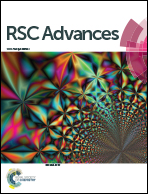Tailoring base catalyzed synthesis of palm oil based alkyd resin through CuO nanoparticles†
Abstract
Palm oil based alkyd resin was synthesized by an alcoholysis–polyesterification process over a base catalyst tailored by copper oxide (CuO) nanoparticles. In the present paper we synthesized CuO sol in glycerol and subsequently used it in alkyd resin synthesis. The formation of the alkyd resin was confirmed by FTIR, Raman, 1H-NMR and 13C-NMR methods and its molecular weight was determined by gel permeation chromatography (GPC). The antimicrobial activity of the pseudo-homogeneous additive was determined via the Kirby–Bauer method and the stability of the CuO was determined by X-ray absorption near edge structure spectroscopy (XANES). The addition of CuO nano-sol to the conventional homogeneous base catalyzed system explored a new catalytic route for the preparation of bioresin from vegetable oil, reducing the reaction time as well as adding antimicrobial properties to the resin.


 Please wait while we load your content...
Please wait while we load your content...